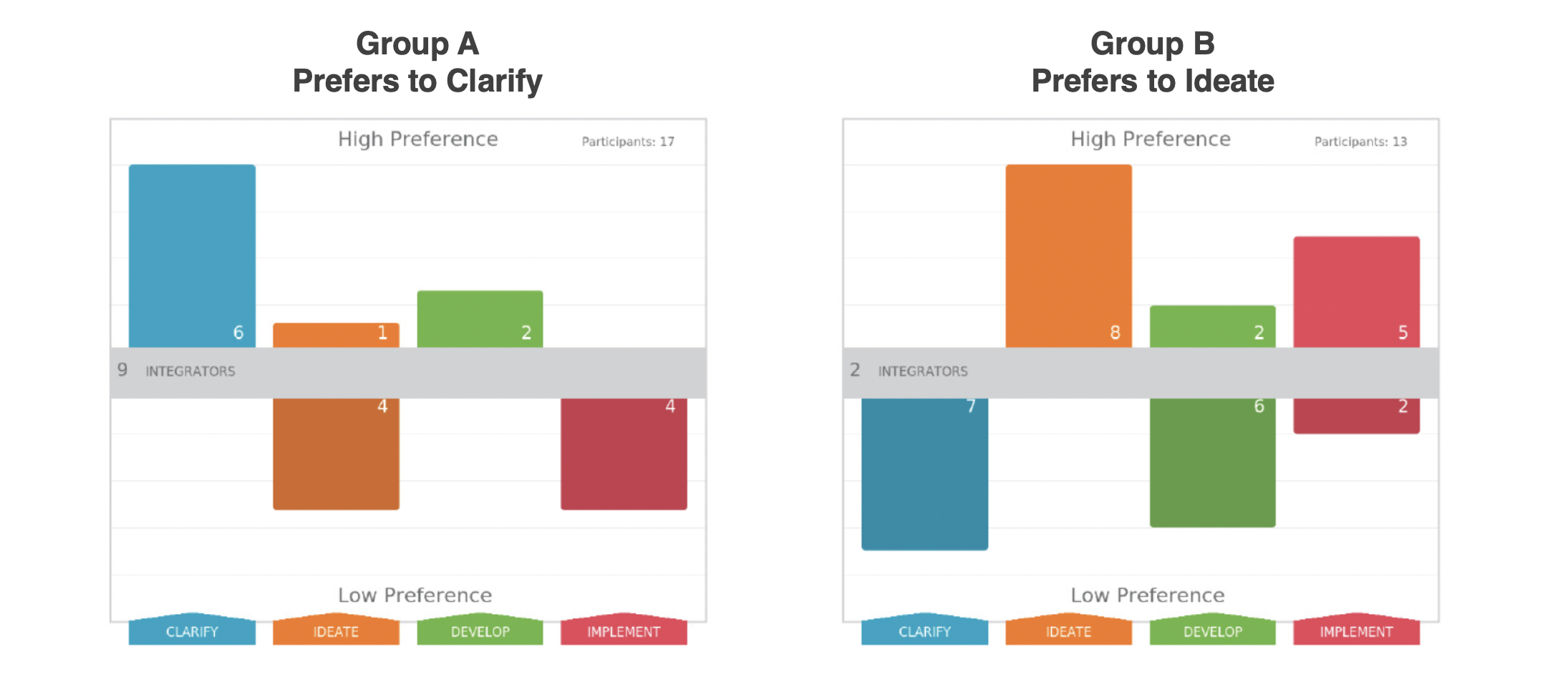Do You Play Favorites?
Posted on February 27, 2025

Dorte Nielsen, founder of the Center for Creative Thinking in Copenhagen, gave the FourSight assessment to the faculty of a Danish high school. She gathered all the teachers in the cafeteria, handed out their results, and asked them what they had learned from their thinking preferences. One teacher stood up and said, “I teach math,” he said, “and I like to clarify. I’ve always thought my job was to pour as much information as possible into my students’ heads. Now I realize that’s just my preference. I was boring three quarters of my students to death.”
Another teacher stood up. “Don’t feel bad,” she said. “I’m a social studies teacher, and I prefer to implement. Every time I give an assignment, the same five students come to my desk to ask questions about it. I tell them, ‘Just jump in! Figure it out as you go!’ Now I realize they must prefer to clarify. They actually need more direction to get started.”
Turkish researcher, Serap Ozdemir, found that the age-old concept of teacher’s pet may actually be connected to thinking preferences. Serap found that teachers tend to look more favorably on students who share their thinking preferences. She gave 275 teachers the FourSight Thinking Profile and asked them to complete a checklist to describe their ideal student. Teachers overwhelmingly agreed on the same core character traits of honesty, kindness, and trustworthiness, but after that, she found their thinking preferences influenced their idea of who was an ideal student. Teachers who prefer to clarify idealize students who are prompt, organized, and serious (i.e., students who prefer to clarify). Teachers who prefer to ideate idealized students who were playful, imaginative, spontaneous, and original (i.e., students who prefer to ideate).[1]
You can be sure that teachers aren’t the only ones to play favorites. Leaders do it too.
When she works with corporate clients, Dorte, whose background is in advertising, uses a graphic example to teach the blind spot phenomenon to corporate leaders. She flashes two FourSight group profiles on the screen. The first group clearly has a preference to clarify. The second group prefers to ideate.
“Think about how these two groups will get along,” she says, challenging the leaders in her workshop to guess. “How will the clarify group see the ideate group?”
“As too playful. Not detailed enough. Disorganized. Not conscientious. Too imaginative,” are often their answers.
“Right. That’s just what the research tells us. And how will the ideate group likely see the clarify group?” asks Dorte.
“As too uptight. Too serious. Too cautious. Too rule bound. Unimaginative,” are the usual leaders’ responses.
“Right again,” she says.
Then Dorte does the big reveal. “These are real life groups. The clarify group are students. The ideate group are their teachers.” This is often a cue for an audible gasp in the room.
Dorte then shares the unconscious assumptions of each group: the teachers thought their students would want to explore new, original approaches to the topic and would get bored by too many details or too much reading. But the students wanted nothing more than facts, detailed information, and a chance to ask lots of questions. Both groups were doomed to a miserable semester until Dorte revealed their thinking preferences. She recalled, “The teachers laughed out loud when they saw these profiles. One said laughing, ‘Ah, that's why they didn't enjoy dancing during the math class.’” Once the teachers understood how their students liked to think, they happily altered their approach to better suit the students’ needs. The two groups ended up with a very positive relationship. Next year, they’d have to do it all over again because the new batch of students might have an entirely different set of thinking preferences.
Dorte shows her corporate clients the FourSight group profiles of their own departments and working teams. Often there are stark contrasts. In the creative agencies she serves, the finance department typically favors clarifying. The creative department prefers ideating. Account managers and media buyers often prefer to clarify and implement. The classic antipathy that often develops between those groups feels personal, but it’s easily explained by thinking preferences. Before they understand thinking preferences, different departments may look on each other with suspicion, but by the time Dorte is finished with them, they see how everyone contributes to the whole.
[1] Gurak-Ozdemir, S., Acar, S., Puccio, G., & Wright, C. (2019). “Why do teachers connect better with some students than others? Exploring the influence of teachers’ creative thinking preferences.” Gifted and Talented International, p.1-14.
This article is an excerpt from the upcoming book, "Good Team, Bad Team: Lead People to Go After Big Challenges, Not Each Other," written by FourSight partners, Sarah Thurber and Blair Miller PhD.
Sarah is managing partner at FourSight and the award-winning author of Good Team, Bad Team, The Secret of the Highly Creative Thinker, Creativity Unbound, and Facilitation: A Door to Creative Leadership. Her work helps teams and leaders think creatively, work collaboratively and perform at their best.
Ready to learn more about FourSight?
Contact us today to learn more about our offer and how FourSight can help your teams work better together.
If you'd like to learn more about FourSight before scheduling a call, click below to learn about our platform and the science behind FourSight.
